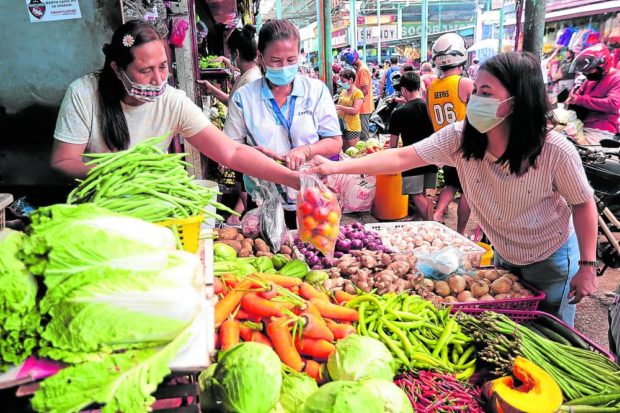Philippines’ February inflation seen at 8.8%, new 14-yr-high
Inflation in the Philippines may have risen to a new 14-year-high of 8.8 percent in February, according to Goldman Sachs, adding voice to forecasts pointing to yet another possible peak.
The economic research team at the US-based financial services firm said their forecast was higher than the Bloomberg consensus, where forecasters agreed on inflation holding steady at 8.7 percent, same as in January.
Goldman Sachs expects the inflation to rise by a seasonally adjusted 0.5 percent in February compared to January prices, which is slower than the 1.2 percent month-on-month rise in January compared to December.
This is “mainly due to higher meat and fish prices, and an increase in domestic fuel prices,” the American group said.
The government’s continuing difficulty in reining in food prices was one factor that prompted GlobalSource Partners to raise its full-year inflation outlook to 6.5 percent from 4.8 percent previously.
This is far higher than the upper end of the government’s target range of 2 percent to 4 percent.
“Although we would like to believe that food prices will eventually turn down given reports of import orders that have been issued to relieve domestic shortages, leadership and institutional weaknesses in the agriculture department and elsewhere seem to argue against a speedy disinflation,” said Romeo Bernardo and Marie Christine Tang, who penned the report.
“We note too that despite easing world food prices, the price of rice has ticked up at a time when local production shortfalls have been projected,” they added.
Better outlook
Even then, GlobalSource raised its economic growth outlook for the Philippines to 5.5 percent or 0.5 percentage point higher than the previous forecast.
However, there remain uncertainties about whether the country could cash in on opportunities like China’s reopening.
The New York-based think tank said that, like in 2022, they are not quite sure if surprises ahead will be pleasant or otherwise for the Philippines.
GlobalSource Partners’ revised forecast is still below the government’s target range of 6 percent to 7 percent, and slower than the 7.6 percent reported for 2022.
They said the new forecast comes with “major downside risks,” including the government’s continued lapses in managing food supplies that have contributed to skyrocketing prices of basic goods.
Another major risk cited was President Marcos Jr.’s upcoming choice for Bangko Sentral ng Pilipinas (BSP) Governor—with the incumbent Felipe Medalla’s term expiring in July—as well as possible mid-year changes in the cabinet.
GlobalSource said the choice for BSP chief was critical for preserving the confidence that markets have in Medalla.
Meanwhile, they expect the cumulative of the BSP’s aggressive monetary tightening last year to dampen consumption.
After keeping the BSP’s policy rate at a record low of 2 percent at the height of the COVID-19 pandemic, the Monetary Board (MB) raised this by a total of 3.5 percentage points (pps) to 5.5 percent over the eight months from May to December.
More monetary tightening
Last February, at this year’s first policy meeting, the MB raised further the rate by 0.5 ppt to 6 percent.
“High inflation has persisted [and] will translate into more monetary tightening with both high inflation and interest rates dampening domestic demand at a time when fiscal policy space is also quite cramped,” GlobalSource Partners said.
Still, they noted that the ratio of the national government’s debt stock to gross domestic product (GDP) settled at 60.9 percent at the end of 2022, which is “much better than the government’s 62 percent program.”
With the Bureau of the Treasury seen to have room to manage borrowings opportunistically, the debt-to-GDP could ease further to the goal of 60 percent “as long as economic growth conditions are met and government keeps to its fiscal consolidation program.”
Meanwhile, the country’s dealings with foreign markets is seen to be also facing risks from more turbulence in financial markets, high and volatile commodity prices, trade disruption due to heightened tensions between the United States and China, and a resurgence in COVID-19 cases. INQ
RELATED STORIES:
Philippine inflation rose to 8.7% in January
Philippine inflation yet to peak; Feb high pegged at 9.3%
PH ‘most vulnerable’ to food, fuel price shocks in Asia-Pacific

